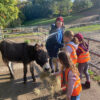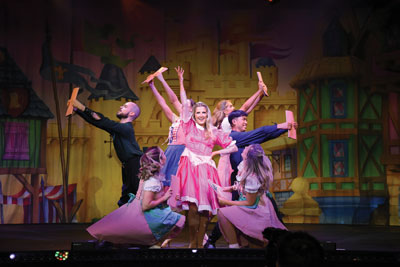
by James Stafford
Brighton Family Panto
This Christmas across the UK, we’ll hear thousands of children screaming “Oh yes it is! Oh no it isn’t! He’s behind you!”
For many children, the pantomime is their very first encounter with live theatre. In a world dominated by screens on tablets, phones and TVs, this is a rare and magical experience. Stepping into a theatre, feeling the buzz of anticipation and seeing a story unfold before their eyes can spark a lifelong love of storytelling, creativity and the arts. Unlike a cinema, where children are expected to sit quietly and absorb the story in silence, the panto invites them to participate, laugh and interact. Pantomimes provide a space where their energy and excitement are not just welcomed, but actively encouraged. The theatre becomes a safe, inclusive and lively environment, where children can express themselves freely, shout, cheer and take part without fear of judgement, celebrating their joy and individuality.
There is something uniquely enchanting about watching characters come to life on stage. The huge and dazzling costumes, the sequins, the energetic songs and the larger-than-life personalities create a world where imagination can roam freely. For many families, this first visit becomes a treasured festive tradition, full of laughter, fun and Christmas magic.
The tradition of panto
Pantomime is a uniquely British institution, combining fairy tales and well-known folk stories with music, comedy and audience participation in a joyous celebration. One of the most beloved elements of panto is its sense of fun and humour. The exaggerated characters, playful jokes and larger-than-life performances make children laugh out loud, often at the very things adults have learned to appreciate in a more subtle way.
At the heart of this tradition is the pantomime dame. Children delight in seeing a clearly grown man dressed as a woman, performing outrageous antics on stage. This playful gender role reversal is central to panto, and much of its comedy springs from the dame’s larger-than-life presence. Beyond the laughs, the dame also introduces children to ideas about performance, identity and self-expression. It’s not just funny, it’s formative. Seeing these playful subversions of traditional gender roles can help children understand that identity is flexible, and that theatre is a space where creativity and self-expression can flourish. In a subtle but meaningful way, pantomimes challenge conventions and encourage children to think more openly about who they are and how they might present themselves in the world.
Participation, laughter and imagination
What truly sets pantomime apart is its interactivity. Children are not passive spectators, they are active participants. Calls of “He’s behind you!” and “Oh no it isn’t!” invite them into the story, giving them confidence, a sense of agency and the joy of a communal experience. In the theatre, children are encouraged to be loud, energetic and fully themselves, something often discouraged in other environments. This safe, playful setting nurtures emotional development and social understanding – all whilst being enormous fun.
Pantomime also teaches children the power of storytelling. Heroes and villains, lessons of right and wrong and the triumph of good over evil are presented with music, comedy and spectacle. These early encounters with narrative structure, dramatic tension and humour leave lasting impressions, shaping how children understand stories and performance for the rest of their lives.
Why it matters
In a world dominated by screens, pantomime offers a vital alternative. Live theatre is immediate, immersive and unpredictable. It demands attention, imagination and engagement. It shows children that the real magic happens in shared experience, that stories are best lived as well as watched and that creativity thrives in participation.
Beyond the spectacle, pantomime nurtures curiosity, empathy and emotional intelligence. It encourages children to dream, to imagine and to engage with the world playfully and thoughtfully. And it leaves memories that families carry for years, embedding a love of theatre and live performance that screens alone cannot replicate.
This Christmas, as theatres across Sussex and the UK fill with children laughing, cheering and joining in, we are reminded why pantomime matters. It is more than a festive tradition, it is an introduction to imagination, creativity and the joy of participation. It sparks wonder, challenges perceptions and opens doors to a world of stories waiting to be discovered. For children, the pantomime is not just entertainment, it is an unforgettable first step into a lifelong love of theatre, laughter and imagination.
James Stafford is part of the Brighton Family Panto Team, who have a beanstalk-sized treat for you this Christmas and a panto packed with tons of fe-fi-fo-FUN! 01273 719759 www.brightonfamilypanto.com hello@brightonfamilypanto.com

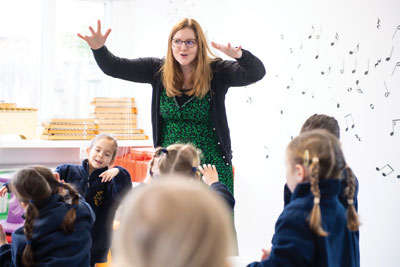
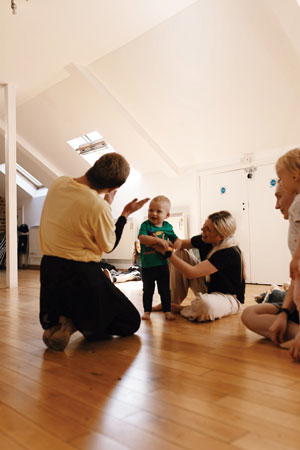

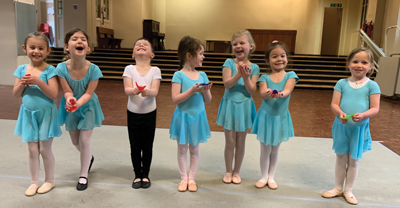

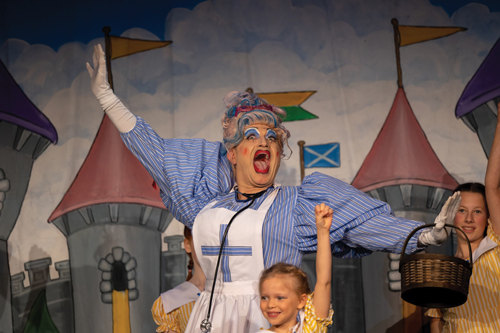
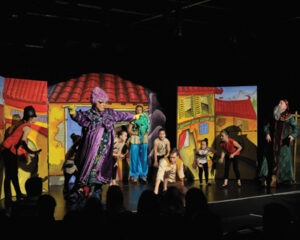 It starts the minute you arrive at the venue. The staff and volunteers all have bright eyes and wide grins that actually look genuine, the café or kiosk is serving Christmas-themed cookies and cupcakes and Christmas pudding flavoured ice-cream. The bar is serving large glasses of everything, including delicious mulled wine. The smell of excited anticipation is everywhere.
It starts the minute you arrive at the venue. The staff and volunteers all have bright eyes and wide grins that actually look genuine, the café or kiosk is serving Christmas-themed cookies and cupcakes and Christmas pudding flavoured ice-cream. The bar is serving large glasses of everything, including delicious mulled wine. The smell of excited anticipation is everywhere.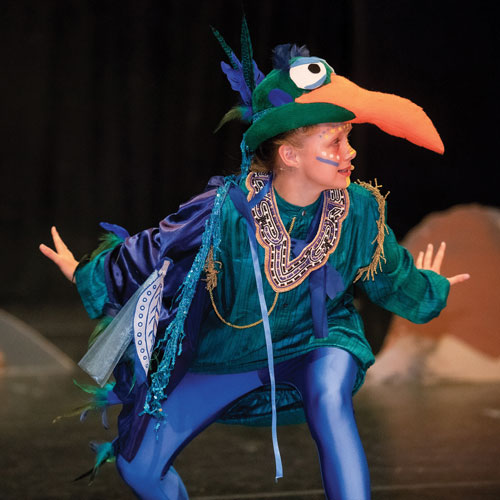
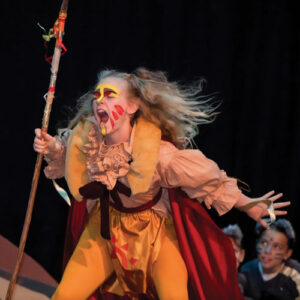 If every opportunity is seized, there is wonderful scope for creating a powerful cross-curricular approach to developing a show. By learning about the literature, history, art, music, and dance that surrounds a story, we cultivate an appreciation for traditions, beliefs, design and stagecraft. As part of the preparations for our school’s recent production of The Lion King this term, the girls studied the patterns, designs and colours used in African prints before creating their own designs for fabrics, masks and marketing materials. They studied each character in the script and crafted symbols and emblems to represent them; meticulously forming links between characters who were related or belonged to the same group. Later, these were hand printed onto fabrics using block printing techniques so that they could finally be made into the cast’s costumes. Through workshops with external educators, they learnt about the importance and significance of symbolism in Adinkra printing; the rhythms and collective energy used in African drumming; and the storytelling techniques, as well as traditional movements, that can be generated through dance. We focused on the importance of recycling materials and made masks and props out of plastic milk bottles. This process was amazing – our girls were captivated by the transformation achieved with these simple objects. In addition to this, by singing songs in African dialects, we enhanced our understanding and appreciation of sounds and languages. The opportunities for extending the students’ learning through stimulating and interlinked topics are boundless.
If every opportunity is seized, there is wonderful scope for creating a powerful cross-curricular approach to developing a show. By learning about the literature, history, art, music, and dance that surrounds a story, we cultivate an appreciation for traditions, beliefs, design and stagecraft. As part of the preparations for our school’s recent production of The Lion King this term, the girls studied the patterns, designs and colours used in African prints before creating their own designs for fabrics, masks and marketing materials. They studied each character in the script and crafted symbols and emblems to represent them; meticulously forming links between characters who were related or belonged to the same group. Later, these were hand printed onto fabrics using block printing techniques so that they could finally be made into the cast’s costumes. Through workshops with external educators, they learnt about the importance and significance of symbolism in Adinkra printing; the rhythms and collective energy used in African drumming; and the storytelling techniques, as well as traditional movements, that can be generated through dance. We focused on the importance of recycling materials and made masks and props out of plastic milk bottles. This process was amazing – our girls were captivated by the transformation achieved with these simple objects. In addition to this, by singing songs in African dialects, we enhanced our understanding and appreciation of sounds and languages. The opportunities for extending the students’ learning through stimulating and interlinked topics are boundless.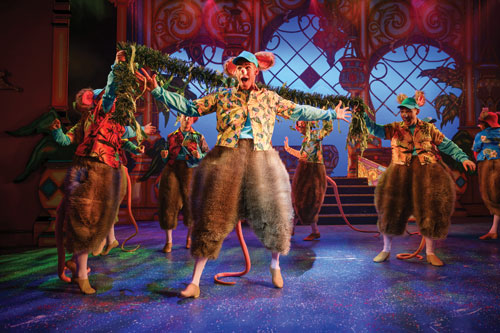
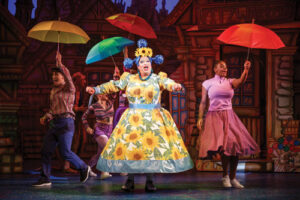 Children’s empathy and emotional intelligence are developed through everyday interaction but they are also nurtured by music, books, and in particular, watching live theatre performances. When watching characters interact on stage, we as the audience connect with them and experience what they are thinking and feeling as if we were thinking or feeling it ourselves – we are practicing how to understand others. Having a safe space to explore difficult emotions is essential to strengthening empathetic muscles and live theatre provides the perfect platform for this. Bill English, founder of the San Francisco Playhouse, states that: “Theatre is like a gym for empathy. It’s where we go to build up the muscles of compassion, to practice listening and understanding and engaging with people that are not just like ourselves. We practice sitting down, paying attention and learning from other people’s actions. We practice caring.”
Children’s empathy and emotional intelligence are developed through everyday interaction but they are also nurtured by music, books, and in particular, watching live theatre performances. When watching characters interact on stage, we as the audience connect with them and experience what they are thinking and feeling as if we were thinking or feeling it ourselves – we are practicing how to understand others. Having a safe space to explore difficult emotions is essential to strengthening empathetic muscles and live theatre provides the perfect platform for this. Bill English, founder of the San Francisco Playhouse, states that: “Theatre is like a gym for empathy. It’s where we go to build up the muscles of compassion, to practice listening and understanding and engaging with people that are not just like ourselves. We practice sitting down, paying attention and learning from other people’s actions. We practice caring.”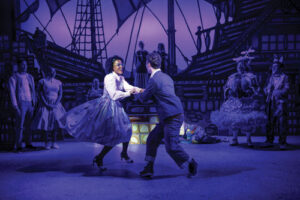 to the theatre can be a fantastic way of making lasting memories and spending real quality time together. For children (and grownups!) going to see a play feels like something special, something out of the ordinary. Whether it’s the grandeur of the building itself, finding your red velvet seats or begging for a tub of ice cream in the intermission, the experience of going to the theatre is something unique before the play has even begun.
to the theatre can be a fantastic way of making lasting memories and spending real quality time together. For children (and grownups!) going to see a play feels like something special, something out of the ordinary. Whether it’s the grandeur of the building itself, finding your red velvet seats or begging for a tub of ice cream in the intermission, the experience of going to the theatre is something unique before the play has even begun.


